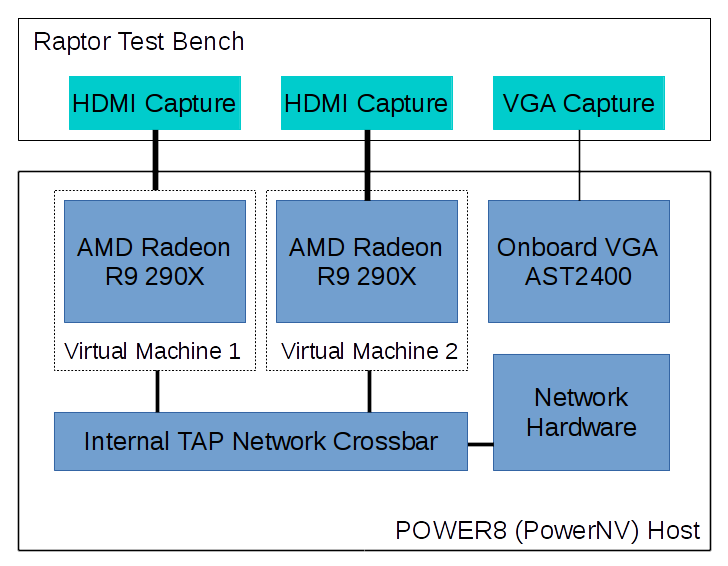QEMU KVM VFIO Passthrough and AMD GPU Demonstration
This video demonstrates effective use of virtual machines with direct GPU access to get the most out of your Talos™ machine.
OpenPOWER fully supports advanced virtualization technologies, including PCI device passthrough when used with a PowerNV system, KVM, and the HV module. We demonstrate the power of this virtualization support below by launching two separate virtual machines, each with its own dedicated AMD Radeon GPU attached, and putting both virtual machines and GPUs under moderate load simultaneously.
System Configuration
Demonstration
For the best viewing experience, expand the video to full screen mode on your device. A screen resolution of at least 1920 x 1080 pixels is recommended.
NOTE: This video is available in native 4K resolution for those with 4K-compatible devices. The high-resolution 1080p version below is scaled down to 1/4 of the 4K native resolution, and some fine and/or text detail may have been lost in the scaling process.
|
|
|
General Notes
|
|
VFIO Configuration and QEMU Launch The following commands will isolate the GPU at PCI bus location 0000:01:00 (GPU core [1002:67b0], HDMI audio [1002:aac8]), then prepare it for attachment to a virtual machine:
modprobe vfio-pci
echo "1002 67b0" > /sys/bus/pci/drivers/vfio-pci/new_id
echo "1002 aac8" > /sys/bus/pci/drivers/vfio-pci/new_id
echo 0000:01:00.0 > /sys/bus/pci/devices/0000\:00\:00.0/0000\:01\:00.0/driver/unbind
echo 0000:01:00.1 > /sys/bus/pci/devices/0000\:00\:00.0/0000\:01\:00.1/driver/unbind
echo 0000:01:00.0 > /sys/bus/pci/drivers/vfio-pci/bind
echo 0000:01:00.1 > /sys/bus/pci/drivers/vfio-pci/bind
echo "1002 67b0" > /sys/bus/pci/drivers/vfio-pci/remove_id
echo "1002 aac8" > /sys/bus/pci/drivers/vfio-pci/remove_id Once the GPU has been prepared, it can be attached to a newly started virtual machine via the "-device vfio-pci" arguments to QEMU:
qemu-system-ppc64 --enable-kvm -M pseries -cpu host -m 32G -device vfio-pci,host=0000:01:00.0 -device vfio-pci,host=0000:01:00.1 qemu-pcie-passthrough-vm-1.qcow2
|
| All data and information provided on this page is for informational purposes only. Raptor Engineering makes no representations as to accuracy, completeness, currentness, suitability, or validity of any information on this page and will not be liable for any errors, omissions, or delays in this information or any losses, injuries, or damages arising from its display or use. All information is provided on an as-is basis. All product names, logos, and brands are property of their respective owners. All company, product and service names used in this page are for identification purposes only. Use of these names, logos, and brands does not imply endorsement. Edited and encoded on OpenPOWER using libre software! |
Back to the Talos™ prerelease page




